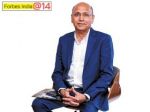
Electronics manufacturing sector needs to be self-reliant and invest heavily in R&D: Sunil Vachani
For the July 2022 cover story that featured Sunil Vachani, we looked at the entrepreneur's journey in building Dixon as one of India's largest electronics manufacturing companies. Close to a year later, he writes about how the company is working on various innovations and planning its expansion into newer sectors
 Sunil Vachani, co-founder and chairman, Dixon Technologies Image: Madhu Kapparath
Sunil Vachani, co-founder and chairman, Dixon Technologies Image: Madhu Kapparath
Dixon Technologies has gone through a complete transformation in the last 14 years, in many different aspects. Back when we started, Dixon was focussed on just one product category: CRT televisions. This meant a major chunk of our revenue was coming from a single customer.
But as Dixon has grown over the years, so has the electronics manufacturing sector (EMS) in India.
When I had just started building Dixon, the thought process was that our strength as a country lies in software. But over time, people have realised that we need to have strength both in services and manufacturing. Another transformation was the change in the mindset of financial institutions and investors. I remember when I was going through my IPO roadshows, investor interest was lukewarm. That has changed now. I think there are six companies in the Indian EMS sector that are listed, and they are the darlings of the stock market in terms of the huge returns provided to investors.
Also read: Dixon Technologies: From a single factory in 1993 to a Rs 10,700 crore electronic manufacturer for the world
The focus for the next 14 years is going to be on global markets and setting up manufacturing units in global markets too. If India has to turn into a global electronics manufacturing hub, we need mega factories employing more than 50,000 people. So, one can expect a lot more consolidation in the coming decade.
The production-linked incentive scheme has been hugely beneficial for certain sectors such as smartphone manufacturing. But, as an industry, we need to start looking beyond that: The sector needs to start becoming more self-reliant. For that, the sector and Dixon will have to invest heavily in research and development and in the component ecosystem, which needs a drastic transformation.
Artificial intelligence is going to play a key role in manufacturing in terms of processes. Dixon is also working on a lot of initiatives and smart manufacturing, which includes automation, artificial intelligence and machine learning. We are also working heavily in the space of data analytics and decisions being made based on data, rather than gut and instinct.
For Dixon, the big thing that we are looking forward to is designing our own products. So far, the company has been more of a prescriptive manufacturer, so that will change. We are hoping to enter many new product categories too. Dixon’s product portfolio has always been high volume and low margin. We want to now start looking at product categories that are high margin, such as electric vehicles, defence, drones, medical electronics, and telecom infrastructure. Indian electronics manufacturing will definitely be a sector to watch out for in the next 14 years, and a lot of big changes are expected.
(As told to Naini Thaker)
(This story appears in the 16 June, 2023 issue of Forbes India. To visit our Archives, click here.)
Post Your Comment

















